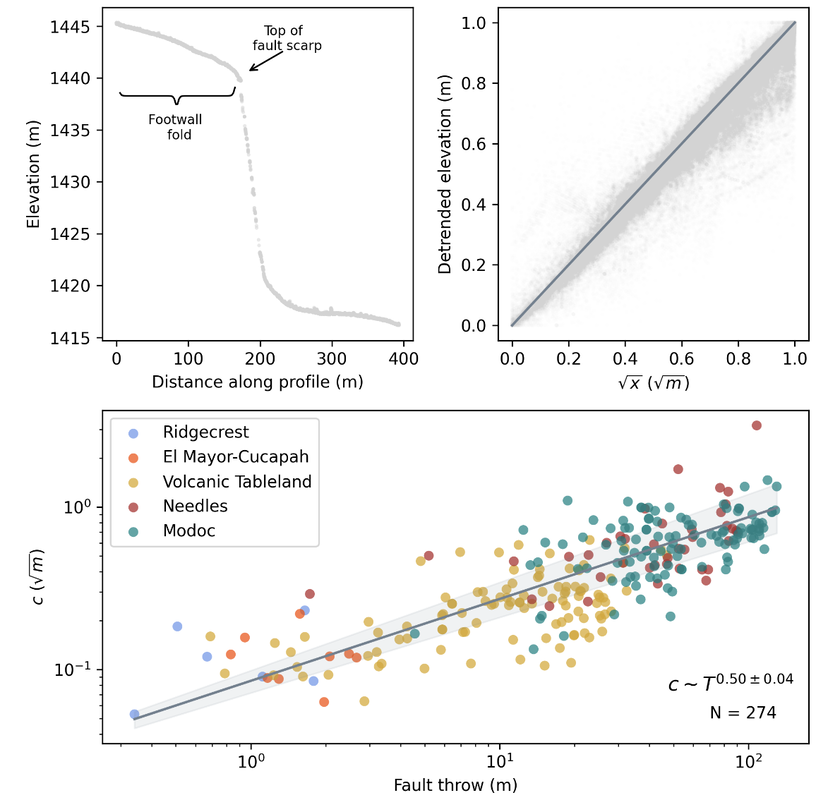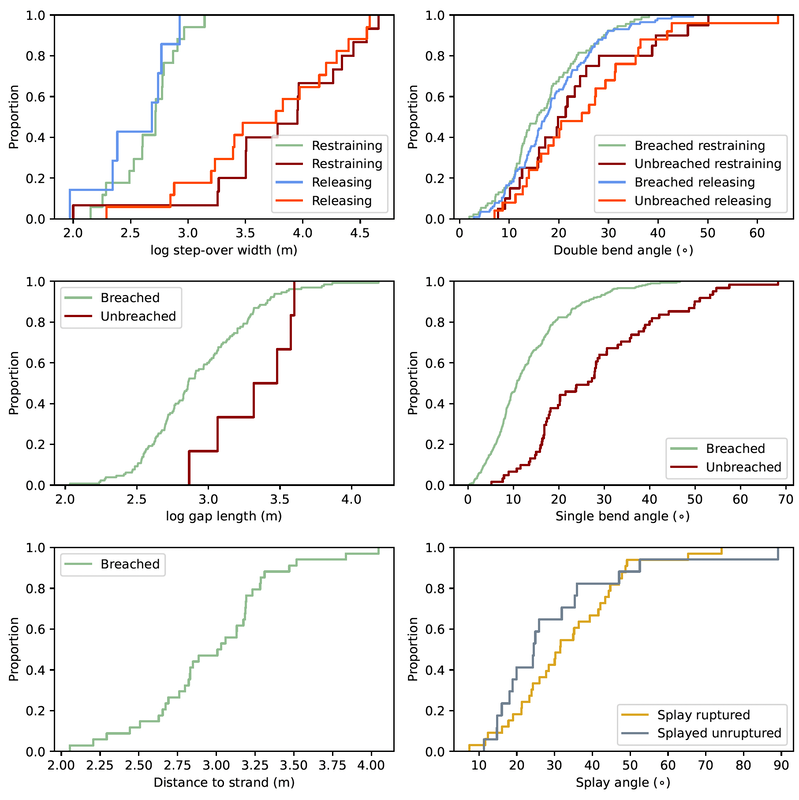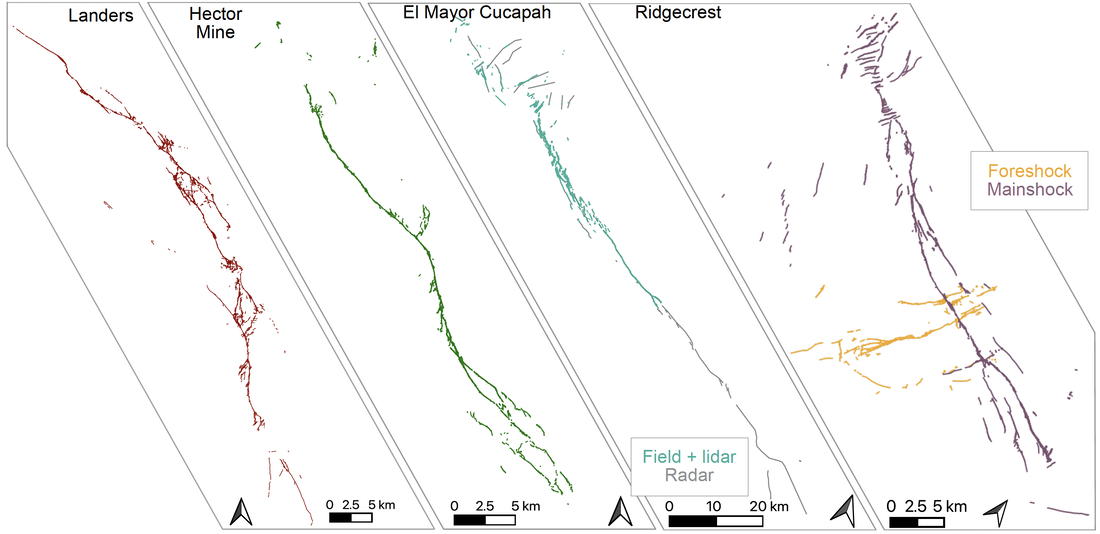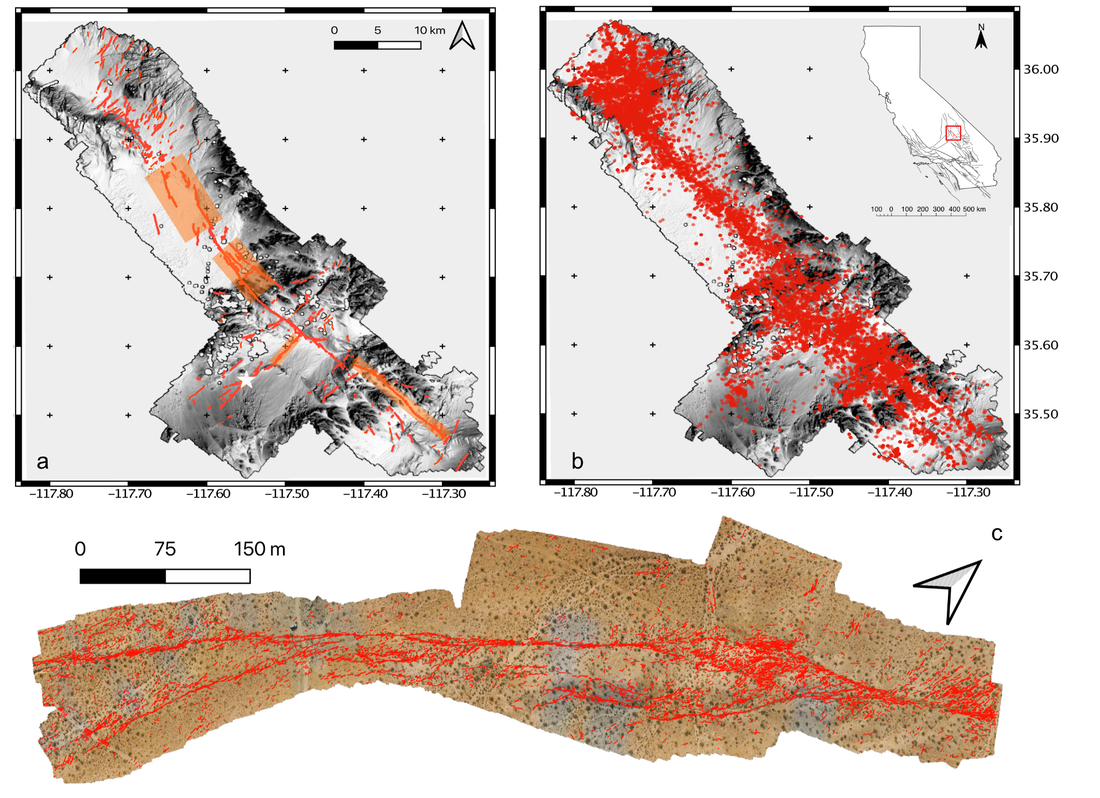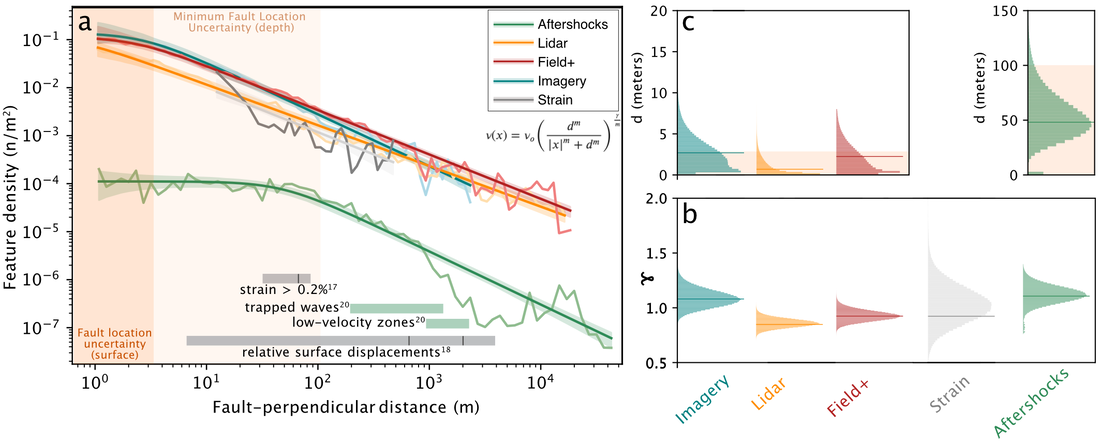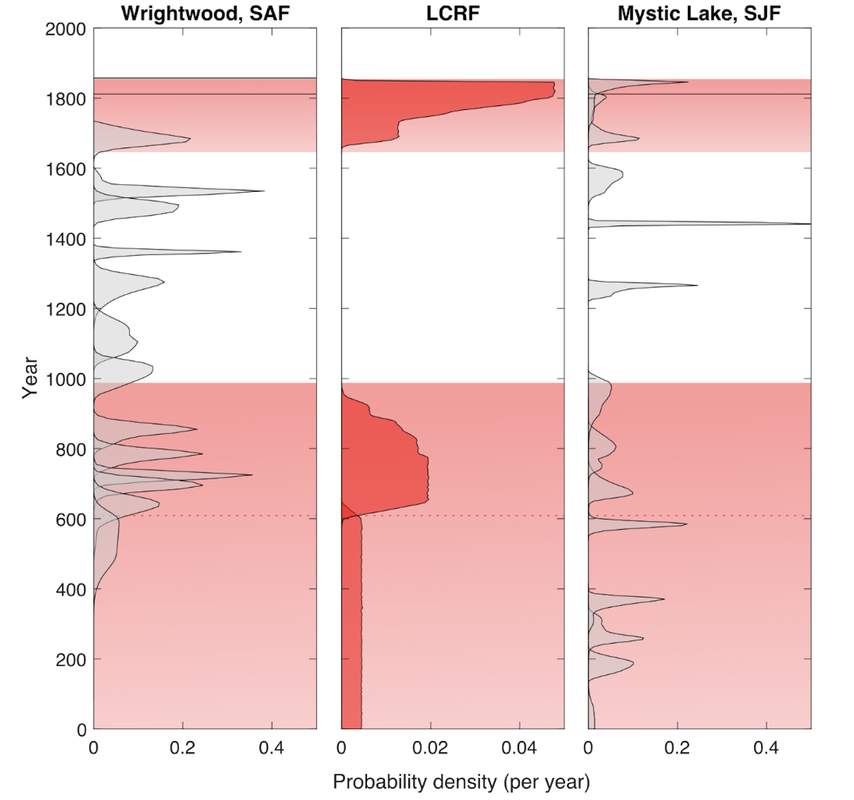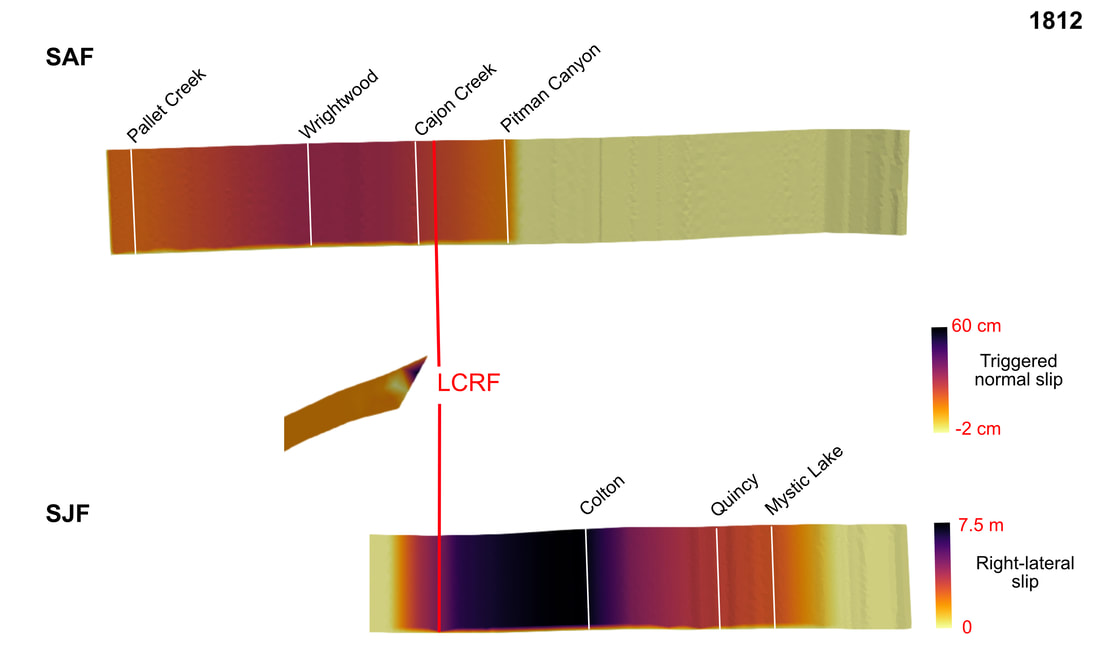Active projects
Measuring permanent off-fault folding adjacent to normal faults
|
Funding: NASA FINESST fellowship, UC Davis Graduate Student Researcher Award in Engineering and Computer Sciences
Project description: We use dense lidar point clouds to quantify subtle warping in the surrounding volume of normal faults in the Needles District (UT), the Volcanic Tableland (CA), and the Modoc Plateau (CA). We investigate the folding strains accumulated over long-timescales, systematically quantify folding shape, assess the evolution of folding amplitude over time, and investigate the mechanism controlling the folding shape. We supplement our lidar-based analysis with field data from the Volcanic Tableland (Bishop, CA) to investigate the mechanisms that accommodate permanent folding strains within the rock volume. Presentations: Poster presentation at the SCEC 2021 Meeting. Oral presentation at the 2022 SSA Annual Meeting. Abstract here. Oral presentation at the 2022 Gordon Research Seminar in Rock Deformation. Poster presentation at the SCEC 2022 Meeting. Oral presentation at the AGU 2023 Meeting (Invited). |
The role of geometrical complexity in rupture propagation and arrest in strike-slip earthquakes
|
Funding: NASA FINESST fellowship
Project description: Earthquake gates act as barriers to rupture propagation, where material properties, rupture dynamics, and the availability and geometry of neighboring faults control the probability of throughgoing rupture. We map step-overs, bends, gaps, splays, and strands from the surface ruptures of 31 strike-slip earthquakes at 1:50,000 scale, classifying each population into breached and unbreached groups. Our analysis yields passing probabilities, quantified as logistic distributions, that are based on fault geometry and kinematics. Using our probabilistic framework, we estimate an event likelihood for each event as the joint passing probability of its breached gates. Though our results are limited by the magnitudes of available mapped surface-rupturing events, our results suggests earthquake frequency-magnitude scaling could in part controlled by the number and characteristics of the earthquake gates present along a fault. Presentations: Invited oral presentation at the AGU 2022 Fall Meeting. Abstract here. Oral presentation at the 2023 SSA meeting. Publications:
|
Past projects
A framework for incorporating widespread coseismic fracturing into PFDHA
|
Funding: NASA FINESST fellowship, PG&E Research Award.
Project description: Widespread distributed fracturing during earthquakes threatens infrastructure and lifelines. We combine high-resolution surface rupture maps from the four major surface-rupturing strike-slip earthquakes in southern California and northern Mexico since 1990 to incorporate the displacements produced by secondary faulting and fracturing into a probabilistic displacement hazard analysis framework. Through analysis of the length and density distribution of mapped fractures for each event, we develop an expression for the probability of finding a fracture at a given distance away from the fault that accommodates a displacement that exceeds a given threshold Do. In our model, Do is a user-input variable that may be adjusted for different engineering applications. To facilitate general use, we also recast this relationship in terms of earthquake magnitude. These relationships may be used to simulate the expected secondary displacements for strike-slip earthquakes with widespread fracturing across immature fault zones, such as the Eastern California Shear Zone or the Walker Lane Belt of California and Nevada, USA. Presentations: Poster presentation at the SCEC 2022 Annual Meeting. Publications:
|
Characterizing Widespread Inelastic Deformation From Integrated Fracture, Aftershock and Strain Maps
|
Funding: Southern California Earthquake Center (SCEC) Awards 19209 and 20155, NASA FINESST fellowship.
Collaborators: Dr. Chris Milliner (JPL/Caltech), Andreas Plesch (Harvard) Project description: Fault damage zones constitute a permanent sink of strain energy, modify the elastic properties of the shallow crust, threaten lifelines, and amplify ground shaking during earthquakes. The 2019 Ridgecrest earthquake sequence provides an unprecedented view of the distribution of inelastic deformation from high-resolution imaging, geodetic data, and earthquake catalogs. This rich dataset lets us investigate the properties of the damage zone in detail and across different spatial scales, and to compare them to prior constraints on the extent of damage. . Presentations: Poster presentation at the 2020 SCEC Annual Meeting. Abstract here. Oral presentation at the 2021 SSA Annual Meeting. Video link here. This presentation received an Outstanding Student Presentation Award. Oral presentation at the 2021 AGU Fall Meeting. Video link here. Publications:
|
Frequency and mechanics of multi-fault earthquakes through Cajon Pass
|
Funding: Southern California Earthquake Center (SCEC) Awards 18040 and 20150
Collaborators: Tom Rockwell (San Diego State University), Drake Singleton (USGS), Irina Delusina (UC Davis) Project description: We have developed a new paleoseismic dataset and suite of mechanical models to better understand the probability of joint-rupture through the Cajon Pass Earthquake Gate. We combined paleoseismic trenching with Bayesian analysis of radiocarbon ages and statistical analysis of invasive pollen species to constrain the timing of co-rupture of the San Andreas and San Jacinto faults in the past 2500 years. We paired our chronology with those from other paleoseismic sites along the San Andreas and San Jacinto faults to understand the probability of joint rupture and the spatial extent of multi-fault events in Southern California. We developed a suite of 3d finite element mechanical models in Pylith to constrain slip models for the 1812 and 1857 events based on our trench data and prior studies, resolving the mechanical conditions that favor co-rupture through Cajon Pass. Presentations: Poster presentation at the SCEC 2019 Annual Meeting. Abstract here. Invited oral presentation at the 2020 SCEC Cajon Pass Earthquake Gate Area: Progress and Future Plans. Abstract here. Oral presentation at the 2022 SSA Annual Meeting. Abstract here. Publications:
|
